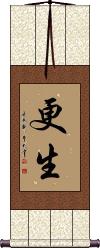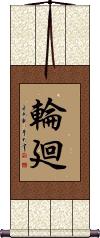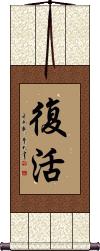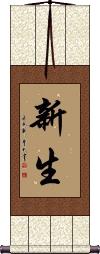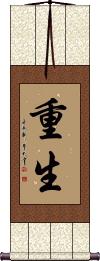Many custom options...
And formats...

Rebirth in Chinese / Japanese...
Buy a Rebirth calligraphy wall scroll here!
Personalize your custom “Rebirth” project by clicking the button next to your favorite “Rebirth” title below...
Rehabilitation / Rebirth
This is a Chinese, Korean and Japanese word that means rebirth or resurrection.
Other definitions include reinvigorated, rejuvenated, a new lease of life, rehabilitation, remaking one's life, starting life anew, regeneration, reorganization, rebuilding, recovery, restoration, remaking, coming back to life, revival, or resuscitation.
Samsara / Endless Cycle of Rebirth
輪廻 is one of a few ways to express संसार or Saṃsāra in Chinese, Japanese, and old Korean.
The Buddhist term can be translated in several ways, including:
An endless cycle of death and rebirth.
The turning of the wheel.
To revolve.
Transmigration in six ways.
The wheel of transmigration.
The round of existence.
Resurrection / Re-Birth
復活 is the Chinese, Japanese and Korean word for resurrection or rebirth.
復活 literally means “return to life.”
It is the term used in most Asian Bibles to refer to the resurrection of Christ. In Japanese, it is sometimes used to mean a Christian Revival. In some contexts, it can mean resuscitation.
See Also: Christianity | Jesus Christ | God of Abraham
New Life
新生 literally means “new life” or “new birth” in Chinese, Japanese Kanji, and old Korean Hanja.
Depending on the context, this word can also mean newborn, new student, rebirth, new birth, or nascent.
In Japanese, this can be the given name Wakaki.
Note: This is not the most common word selection for a calligraphy wall scroll. But if you’re a westerner, you can bend the rules a bit.
Phoenix Rise from the Ashes
鳳凰涅磐 is a proverb that suggests “Legendary Phoenix rises from the ashes.” It means “Legendary Phoenix [reaches] Nirvana.”
There is a legend in China of a great bird reborn once every 500 years. This bird gathers all the ill will, suffering, desire, and other negative things of the world. The bird then plunges into the fire to burn away all negative things, sacrificing itself in the process (achieving Nirvana, or perhaps allowing others the opportunity to reach Nirvana).
500 years later, the phoenix is reborn from the ashes again, and the cycle repeats.
Re-Birth / Renaissance
重生 is the Chinese word for rebirth. This can be used literally or metaphorically. As a metaphor, you could use this to say something like, “We are watching the rebirth of New Orleans after the disaster of Katrina.”
重生 is sometimes translated as “renaissance.”
Note: 重生 is not the Buddhist concept of reincarnation or re-birth.
See Also: Reincarnation
These search terms might be related to Rebirth:
New Beginning
Re-Birth / Renaissance
Reincarnation (Buddhism)
Reincarnation / Life in Flux
Reincarnation / Transmigration of Souls
Resurrection / Re-Birth
Not the results for rebirth that you were looking for?
Below are some entries from our dictionary that may match your rebirth search...
| Characters If shown, 2nd row is Simp. Chinese |
Pronunciation Romanization |
Simple Dictionary Definition |
天 see styles |
tiān tian1 t`ien tien hiroshi ひろし |
More info & calligraphy: Heaven(1) sky; (2) {Christn} heaven; (3) God; (4) {Buddh} svarga (heaven-like realm visited as a stage of death and rebirth); (5) {Buddh} deva (divine being of Buddhism); (6) top (of a book); (7) sole (of a Japanese sandal); (8) beginning; start; (9) (abbreviation) (See 天ぷら) tempura; (10) (abbreviation) (obsolete) (See 天竺・1) India; (given name) Hiroshi Heaven; the sky; a day; cf. dyo, dyaus also as 提婆 a deva, or divine being, deity; and as 素羅 sura, shining, bright. |
業 业 see styles |
yè ye4 yeh waza わざ |
More info & calligraphy: Karmadeed; act; work; performance; (personal name) Hajime karman, karma, "action, work, deed"; "moral duty"; "product, result, effect." M.W. The doctrine of the act; deeds and their effects on the character, especially in their relation to succeeding forms of transmigration. The 三業 are thought, word, and deed, each as good, bad, or indifferent. Karma from former lives is 宿業, from present conduct 現業. Karma is moral action that causes future retribution, and either good or evil transmigration. It is also that moral kernel in which each being survives death for further rebirth or metempsychosis. There are categories of 2, 3, 4, 6, and 10; the 六業 are rebirth in the hells, or as animals, hungry ghosts, men, devas, or asuras: v. 六趣. |
生 see styles |
shēng sheng1 sheng yanao やなお |
More info & calligraphy: Birth / Life(n,n-suf) (See 芝生) area of thick growth (of trees, grass, etc.); (surname) Yanao jāti 惹多; life; utpāda means coming forth, birth, production; 生 means beget, bear, birth, rebirth, born, begin, produce, life, the living. One of the twelve nidānas, 十二因緣; birth takes place in four forms, catur yoni, v. 四生, in each case causing: a sentient being to enter one of the 六道 six gati, or paths of transmigration. |
五戒 see styles |
wǔ jiè wu3 jie4 wu chieh gokai ごかい |
More info & calligraphy: Five Preceptspañca-veramaṇī; the first five of the ten commandments, against killing, stealing, adultery, lying, and intoxicating liquors. 不殺生; 不偸盜; 不邪婬; 不妄語; 不飮酒 They are binding on laity, male and female, as well as on monks and nuns. The observance of these five ensures rebirth in the human realm. Each command has five spirits to guard its observer 五戒二十五神. |
人道 see styles |
rén dào ren2 dao4 jen tao jindou(p); nindou / jindo(p); nindo じんどう(P); にんどう |
More info & calligraphy: The Tao or Dao of Being Human / Humanity(1) humanity; (2) sidewalk; footpath; (3) (にんどう only) {Buddh} (See 六道) human realm rebirth as a human being |
來世 来世 see styles |
lái shì lai2 shi4 lai shih raise |
More info & calligraphy: Eternal Life / Future LifeFuture world, or rebirth. |
地獄 地狱 see styles |
dì yù di4 yu4 ti yü jigoku じごく |
More info & calligraphy: Hell(1) {Buddh} hell realm; Naraka; (2) {Christn} Hell; (3) hell; misery; nightmare; inferno; (4) place where a volcano or hot springs constantly spew smoke or steam; (place-name) Jigoku naraka, 捺落迦 (or 那落迦) ; niraya 泥犂; explained by 不樂 joyless; 可厭 disgusting, hateful; 苦具, 苦器 means of suffering; if 地獄 earth-prison; 冥府 the shades, or departments of darkness. Earth-prison is generally intp. as hell or the hells; it may also be termed purgatory; one of the six gati or ways of transmigration. The hells are divided into three classes: I. Central, or radical, 根本地獄 consisting of (1) The eight hot hells. These were the original hells of primitive Buddhism, and are supposed to be located umder the southern continent Jambudvīpa 瞻部州, 500 yojanas below the surface. (a) 等活 or 更活 Saṃjīva, rebirth, where after many kinds of suffering a cold wind blows over the soul and returns it to this life as it was before, hence the name 等活. (b) 黑繩 Kaslasūtra, where the sufferer is bound with black chains and chopped or sawn asunder. (c) 線合; 衆合; 堆壓 Saṃghāta, where are multitudes of implements of torture, or the falling of mountains upon the sufferer. (d) 號呌; 呼呼; 叫喚 Raurava, hell of wailing. (e) 大呌; 大號呌; 大呼 Mahāraurava, hell of great wailing. (f) 炎熱; 燒炙 Tapana, hell of fames and burning. (g) 大熱; 大燒炙; 大炎熱 Pratāpana, hell of molten lead. (h) 無間; 河鼻旨; 阿惟越致; 阿毗至; 阿鼻; 阿毗 Avīci, unintermitted suffering, where sinners die and are reborn to suffer without interval. (2) The eight cold hells 八寒地獄. (a) 頞浮陀地獄 Arbuda, where the cold causes blisters. (b) 尼刺部陀 Nirarbuda, colder still causing the blisters to burst. (c) 頞哳吒; 阿吒吒 Atata, where this is the only possible sound from frozen lips. (d) 臛臛婆; 阿波波 Hahava or Apapa, where it is so cold that only this sound can be uttered. (e) 虎虎婆 Hāhādhara or Huhuva, where only this sound can be uttered. (f) 嗢鉢羅; 鬱鉢羅 (or 優鉢羅) Utpala, or 尼羅鳥 (or 漚) 鉢羅 Nīlotpala, where the skin is frozen like blue lotus buds. (g) 鉢特摩 Padma, where the skin is frozen and bursts open like red lotus buds. (h) 摩訶鉢特摩 Mahāpadma, ditto like great red lotus buds. Somewhat different names are also given. Cf. 倶舍論 8; 智度論 16; 涅槃經 11. II. The secondary hells are called 近邊地獄 adjacent hells or 十六遊增 each of its four sides, opening from each such door are four adjacent hells, in all sixteen; thus with the original eight there are 136. A list of eighteen hells is given in the 十八泥梨經. III. A third class is called the 孤地獄 (獨地獄) Lokāntarika, or isolated hells in mountains, deserts, below the earth and above it. Eitel says in regard to the eight hot hells that they range 'one beneath the other in tiers which begin at a depth of 11,900 yojanas and reach to a depth of 40,000 yojanas'. The cold hells are under 'the two Tchahavālas and range shaft-like one below the other, but so that this shaft is gradually widening to the fourth hell and then narrowing itself again so that the first and last hell have the shortest, those in the centre the longest diameter'. 'Every universe has the same number of hells, ' but 'the northern continent has no hell whatever, the two continents east and west of Meru have only small Lokāntarika hells... whilst all the other hells are required for the inhabitants of the southern continent '. It may be noted that the purpose of these hells is definitely punitive, as well as purgatorial. Yama is the judge and ruler, assisted by eighteen officers and a host of demons, who order or administer the various degrees of torture. 'His sister performs the same duties with regard to female criminals, ' and it may be mentioned that the Chinese have added the 血盆池 Lake of the bloody bath, or 'placenta tank' for women who die in childbirth. Release from the hells is in the power of the monks by tantric means. |
天使 see styles |
tiān shǐ tian1 shi3 t`ien shih tien shih yukari ゆかり |
More info & calligraphy: Angel / Messenger of Heaven(noun - becomes adjective with の) angel; (female given name) Yukari Divine messengers, especially those of Yama; also his 三天使 three messengers, or lictors— old age, sickness, death; and his 五天使 or 五大使, i. e. the last three together with rebirth and prisons or punishments on earth. |
布施 see styles |
bù shī bu4 shi1 pu shih fuho ふほ |
More info & calligraphy: Dana: Almsgiving and Generosity(n,vs,vi) (1) {Buddh} alms-giving; charity; (n,vs,vi) (2) {Buddh} offerings (usu. money) to a priest (for reading sutras, etc.); (surname) Fuho dāna 檀那; the sixth pāramitā, almsgiving, i. e. of goods, or the doctrine, with resultant benefits now and also hereafter in the forms of reincarnation, as neglect or refusal will produce the opposite consequences. The 二種布施 two kinds of dāna are the pure, or unsullied charity, which looks for no reward here but only hereafter; and the sullied almsgiving whose object is personal benefit. The three kinds of dāna are goods, the doctrine, and courage, or fearlessness. The four kinds are pens to write the sutras, ink, the sutras themselves, and preaching. The five kinds are giving to those who have come from a distance, those who are going to a distance, the sick, the hungry, those wise in the doctrine. The seven kinds are giving to visitors, travellers, the sick, their nurses, monasteries, endowments for the sustenance of monks or nuns, and clothing and food according to season. The eight kinds are giving to those who come for aid, giving for fear (of evil), return for kindness received, anticipating gifts in return, continuing the parental example of giving, giving in hope of rebirth in a particular heaven, in hope of an honoured name, for the adornment of the heart and life. 倶舍論 18. |
復活 复活 see styles |
fù huó fu4 huo2 fu huo fukkatsu(p); fukkaatsu(sk) / fukkatsu(p); fukkatsu(sk) ふっかつ(P); ふっかーつ(sk) |
More info & calligraphy: Resurrection / Re-Birth(n,vs,vt,vi) (1) revival (of an old system, custom, fashion, etc.); restoration; return; comeback; (n,vs,vi) (2) resurrection; rebirth To live again, return to life. |
新生 see styles |
xīn shēng xin1 sheng1 hsin sheng wakaki わかき |
More info & calligraphy: New Life(n,vs,vi) rebirth; new birth; nascent; (given name) Wakaki newly arisen |
更生 see styles |
gēng shēng geng1 sheng1 keng sheng tsugio つぎお |
More info & calligraphy: Rehabilitation / Rebirth(noun/participle) (1) rehabilitation; remaking one's life; starting life anew; (noun/participle) (2) rebirth; regeneration; reorganization; rebuilding; recovery; restoration; remaking; (noun/participle) (3) coming back to life; revival; resuscitation; (given name) Tsugio rebirth |
正念 see styles |
zhèng niàn zheng4 nian4 cheng nien shounen / shonen しょうねん |
More info & calligraphy: 7. Right Mindfulness / Right Memory / Perfect Mindfulness(1) {Buddh} (See 八正道) right mindfulness; (2) true faith (in rebirth in the promised land); (place-name) Shounen samyak-smṛti, right remembrance, the seventh of the 八正道; 'right mindfullness, the looking on the body and the spirit in such a way as to remain ardent, self-possessed and mindful, having overcome both hankering and dejection. ' Keith. |
輪廻 轮廻 see styles |
lún huí lun2 hui2 lun hui rinne りんね |
More info & calligraphy: Samsara / Endless Cycle of Rebirth輪轉 saṃsāra, the turning of the wheel, to revolve, i.e. transmigration in the six ways, the wheel of transmigration; the round of existence. |
重生 see styles |
chóng shēng chong2 sheng1 ch`ung sheng chung sheng shigeo しげお |
More info & calligraphy: Re-Birth / Renaissance(given name) Shigeo |
阿修羅 阿修罗 see styles |
ā xiū luó a1 xiu1 luo2 a hsiu lo ashura; asura あしゅら; あすら |
More info & calligraphy: Frightful Demon / Asura{Buddh} Asura; demigod; anti-god; titan; demigods that fight the Devas (gods) in Hindu mythology; (female given name) Ashura asura, 修羅 originally meaning a spirit, spirits, or even the gods, it generally indicates titanic demons, enemies of the gods, with whom, especially Indra, they wage constant war. They are defined as 'not devas', and 'ugly', and 'without wine'. Other forms are 阿須羅 (or 阿蘇羅, or 阿素羅); 阿修倫 (or羅須倫 or 阿修輪 or 羅須輪); 阿素洛; 阿差. Four classes are named according to their manner of rebirth-egg, born, womb-born, transformation-born, and spawn- or water-born. Their abode is in the ocean, north of Sumeru, but certain of the weaker dwell in a western mountain cave. They have realms, rulers, and palaces, as have the devas. The 阿修羅道 is one of the six gatis, or ways of reincarnation. The 修羅場 or 修羅巷 is the battlefield of the asuras against Indra. The 阿修羅琴 are their harps. |
リバース see styles |
ribaasu / ribasu リバース |
More info & calligraphy: Rivers |
輪廻転生 see styles |
rinnetenshou; rinnetensei / rinnetensho; rinnetense りんねてんしょう; りんねてんせい |
More info & calligraphy: Reincarnation / Life in Flux |
釋迦牟尼 释迦牟尼 see styles |
shì jiā móu ní shi4 jia1 mou2 ni2 shih chia mou ni Shakamuni |
More info & calligraphy: Shakyamuni / The Buddha釋迦文 (釋迦文尼); 釋伽文 Śākyamuni, the saint of the Śākya tribe. muni is saint, holy man, sage, ascetic monk; it is: intp. as 仁 benevolent, charitable, kind, also as 寂默 one who dwells in seclusion. After '500 or 550' previous incarnations, Śākyamuni finally attained to the state of Bodhisattva, was born in the Tuṣita heaven, and descended as a white elephant, through her right side, into the womb of the immaculate Māyā, the purest woman on earth; this was on the 8th day of the 4th month; next year on the 8th day of the 2nd month he was born from her right side painlessly as she stood under a tree in the Lumbinī garden. For the subsequent miraculous events v. Eitel. also the 神通遊戲經 (Lalitavistara), the 釋迦如來成道記, etc. Simpler statements say that he was born the son of Śuddhodana, of the kṣatriya caste, ruler of Kapilavastu, and Māyā his wife; that Māyā died seven days later, leaving him to be brought up by her sister Prājapati; that in due course he was married to Yaśodharā who bore him a son, Rāhula; that in search of truth he left home, became an ascetic, severely disciplined himself, and finally at 35 years of age, under a tree, realized that the way of release from the chain of rebirth and death lay not in asceticism but in moral purity; this he explained first in his four dogmas, v. 四諦 and eightfold noble way 八正道, later amplified and developed in many sermons. He founded his community on the basis of poverty, chastity, and insight or meditation, ad it became known as Buddhism, as he became known as Buddha, the enlightened. His death was probably in or near 487 B.C., a few years before that of Confucius in 479. The sacerdotal name of his family is Gautama, said to be the original name of the whole clan, Śākya being that of his branch, v. 瞿, 喬.; his personal name was Siddhārtha, or Sarvārthasiddha, v. 悉. |
南無阿弥陀仏 see styles |
namuamidabutsu なむあみだぶつ |
More info & calligraphy: Namu Amida Butsu |
得 see styles |
dei dei3 tei toku とく |
to have to; must; ought to; to need to (noun or adjectival noun) (1) (also written as 徳) profit; advantage; benefit; gain; (noun or adjectival noun) (2) {Buddh} rebirth in paradise, entering nirvana; (surname) Toku prāp; prāpta. To get, obtain, attain to; got, obtained, etc. |
滅 灭 see styles |
miè mie4 mieh metsu |
to extinguish or put out; to go out (of a fire etc); to exterminate or wipe out; to drown Extinguish, exterminate, destroy; a tr. of nirodha, suppression, annihilation; of nirvāṇa, blown out, extinguished, dead, perfect rest, highest felicity, etc.; and of nivṛtti, cessation, disappearance. nirodha is the third of the four axioms: 苦, 集, 滅, 道 pain, its focussing, its cessation (or cure), the way of such cure. Various ideas are expressed as to the meaning of 滅, i.e. annihilation or extinction of existence; or of rebirth and mortal existence; or of the passions as the cause of pain; and it is the two latter views which generally prevail; cf. M017574 10 strokes. |
趣 see styles |
qù qu4 ch`ü chü shu おもむき |
interesting; to interest (1) meaning; tenor; gist; (2) effect; influence; (3) appearance; aspect; (4) taste; (5) grace; charm; refinement Destination, destiny (especially on rebirth): v. 五趣, i.e. the hells, pretas, animals, man, devas. |
轉 转 see styles |
zhuàn zhuan4 chuan utata うたた |
to revolve; to turn; to circle about; to walk about; classifier for revolutions (per minute etc): revs, rpm; classifier for repeated actions (surname) Utata vartana; pravartana; vṛtti. Turn, transform, revolve, evolve, change, the process of birth and rebirth; again, re-. |
三報 三报 see styles |
sān bào san1 bao4 san pao sanpō |
The three recompenses, i.e. 現報 in the present life for deeds now done; 生報 in the next rebirth for deeds now done; and 後報 in subsequent lives. |
三業 三业 see styles |
sān yè san1 ye4 san yeh sangou / sango さんごう |
{Buddh} (See 身口意) three activities (action, speech and thought) trividha-dvāra. The three conditions, inheritances, or karma, of which there are several groups. (1) Deed, word, thought, 身, 口, 意. (2) (a) Present-1ife happy karma; (6) present-life unhappy karma; (c) 不動 karma of an imperturbable nature. (3) (a) Good; (b) evil; (c) neutral karma. (4) (a) 漏業 Karma of ordinary rebirth; (6) 無漏業 karma of Hīnayāna nirvana; (c) 非漏非無漏 karma of neither, independent of both, Mahāyāna nirvana. (5) (a) Present deeds and their consequences in this life; (b) present deeds and their next life consequences; (c) present deeds and consequences after the next life, There are other groups of three. |
三餘 三余 see styles |
sān yú san1 yu2 san yü sanyo |
The three after death remainders, or continued mortal experiences, of śrāvakas and pratyekabuddhas, who mistakenly think they are going to 無餘涅槃final nirvāṇa, but will still find 煩惱餘 further passion and illusion, 業餘 further karma, and 果餘 continued rebirth, in realms beyond the 三界trailokya. |
不生 see styles |
bù shēng bu4 sheng1 pu sheng fushou / fusho ふしょう |
(place-name) Fushou anutpatti; anutpāda. Non-birth: not to be reborn, exempt from rebirth; arhan is mistakenly interpreted as 'not born', meaning not born again into mortal worlds. The 'nir' in nirvana is also erroneously said to mean 'not born'; certain schools say that nothing ever has been born, or created, for all is eternal. The Shingon word 'a' is interpreted as symbolizing the uncreated. The unborn or uncreated is a name for the Tathāgata, who is not born, but eternal ; hence by implication the term means "eternal". ādi, which means"at first, " "beginning","primary", is also interpreted as 不生 uncreated. |
中有 see styles |
zhōng yǒu zhong1 you3 chung yu chuuu / chuu ちゅうう |
{Buddh} (See 中陰,四有) bardo; state (or period) of intermediate existence between one's death and rebirth (in Japan, 49 days) One of the 四有, i. e. the antarā-bhāva or intermediate state of existence between death and reincarnation; hence 中有之旅 is an unsettled being in search of a new habitat or reincarnation; v. 中陰. |
中蘊 中蕴 see styles |
zhōng yùn zhong1 yun4 chung yün chuuun / chuun ちゅううん |
{Buddh} (See 中陰) bardo; state (or period) of intermediate existence between one's death and rebirth (in Japan, 49 days) intermediate aggregate |
Click here for more rebirth results from our dictionary
The following table may be helpful for those studying Chinese or Japanese...
| Title | Characters | Romaji (Romanized Japanese) | Various forms of Romanized Chinese | |
| Rehabilitation Rebirth | 更生 | kousei / kose kosei / kose | gēng shēng geng1 sheng1 geng sheng gengsheng | keng sheng kengsheng |
| Samsara Endless Cycle of Rebirth | 輪廻 轮廻 | rinne | lún huí / lun2 hui2 / lun hui / lunhui | |
| Resurrection Re-Birth | 復活 复活 | hukkatsu / hukatsu | fù huó / fu4 huo2 / fu huo / fuhuo | |
| New Life | 新生 | waka ki / wakaki | xīn shēng xin1 sheng1 xin sheng xinsheng | hsin sheng hsinsheng |
| Phoenix Rise from the Ashes | 鳳凰涅磐 凤凰涅磐 | fèng huáng niè pán feng4 huang2 nie4 pan2 feng huang nie pan fenghuangniepan | feng huang nieh p`an fenghuangniehpan feng huang nieh pan |
|
| Re-Birth Renaissance | 重生 | chóng shēng chong2 sheng1 chong sheng chongsheng | ch`ung sheng chungsheng chung sheng |
|
| In some entries above you will see that characters have different versions above and below a line. In these cases, the characters above the line are Traditional Chinese, while the ones below are Simplified Chinese. | ||||
Successful Chinese Character and Japanese Kanji calligraphy searches within the last few hours...
